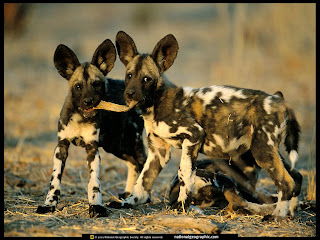IUCN Red List status: Critically endangered
This little nocturnal rabbit can only be found in the Karoo regions and is currently the most endangered mammal in South Africa. It only lives in the deep silt flood plains of seasonal Karoo rivers and can’t be found anywhere else in the world, making it incredibly vulnerable to habitat loss.
Commonly known as the vleihaas,
boshaas, doekvoetjie or pondhaas, the riverine
rabbit is found only in the riverine scrub of the
central Karoo. The first two names arose from its
occurrence in the relatively moist and dense
habitat along the seasonal rivers of the area.
"Doekvoetjie" refers to the broad hind
paws which are furred underfoot. During the 1940s
the curator of the Kaffrarian Museum offered a
pound for each riverine rabbit brought to him,
hence the name "pondhaas".
IDENTIFICATION
The attractive riverine rabbit is easily
identified by the black stripe running from the
corner of its mouth over its cheek, a brown
woolly tail, creamy fur on its belly and throat,
and a broad, club-like hind foot. In the field
hares can be distinguished from rabbits by their
black and white tails. The tails of rabbits are
usually uniformly coloured. Male riverine rabbits
weigh approximately 1,5 kg and females 1,8 kg.
HABITS AND FEEDING
Riverine rabbits feed on their favourite foods,
the boegoe bush and ink bush at night, and rest
up in forms during the day. A form is a shallow
scrape made in the soil under a bush. Two types
of droppings are produced. At night, when the
rabbit is active, hard pellets are deposited.
During the day droppings are soft, taken directly
from the anus, and swallowed. In this way the
riverine rabbit obtains vitamin B, produced by
bacteria in the hind gut, and minerals such as
calcium and phosphorus are recycled.
WHY ENDANGERED?
The riverine rabbit is an endangered species,
i.e. it is in danger of extinction and its
survival is unlikely if the factors causing the
decline remain in effect. The most devastating
threat to the riverine rabbit is the loss of its
habitat. This habitat is limited to the alluvial
floodplains of seasonal rivers in the central Karoo. These flood plains, only 100 - 200 m wide,
are formed when the rivers overflow during
floods, and deposit silt on their banks. This
soil is very good for cultivation compared with
other soils found in the dry Karoo. Over the past
50 years over two-thirds of the riverine rabbit's
habitat has been ploughed over for this purpose.
Other threats to the riverine rabbit's survival
include overgrazing and hunting. Overgrazing of
riverine habitat opens up cover that the rabbit
needs for shelter and to escape predation.
The only way to secure the long
term survival of a species is to protect its
natural habitat. Some Karoo farmers have declared
their farms Natural Heritage Sites to protect the
riverine habitat and rabbit. The Dept. of
Environment and Cultural Affairs (previously Cape
Nature Conservation) encourages farmers to form
conservancies for the same purpose (a conservancy
is a number of adjacent farms on which landowners
cooperate with each other to conserve nature).
Leaving the riverine habitat
intact has advantages for both the farmers and
the riverine rabbit. The Karoo experiences
frequent droughts. Enough rain for cultivation
falls during only a few years every decade. It
would be more productive in the long-term to use
the riverine habitat for grazing rather than to
reap the short-lived benefit of ploughing it for
cultivation.
Riverine vegetation also binds
the soil, preventing it from being washed away in
floods and promotes filtration of rainwater to
groundwater - another benefit for the farmer who
uses windmills to draw up water for his
livestock.
A captive breeding colony is
run at the De Wildt Cheetah Research Station,
outside Pretoria. Plans are afoot to reintroduce
rabbits bred in this colony to suitable habitat
where they no longer occur.
DID YOU KNOW?
* The riverine rabbit is found only in the
central Karoo and nowhere else in the entire
world! This means that the rabbit is endemic to
this area.
* South Africa has two hare
species, the Cape hare and the scrub hare, and
four rabbit species. These are the Natal rabbit,
Smith's rabbit, Jameson's red rock rabbit, and
the riverine rabbit.
* South African rabbits and
hares produce 1 - 3 young per litter. The further
away from the equator rabbit and hare species
occur, the larger their litter sizes. For
example, Alaskan snowshoe hares have seven young
per litter.
* A male rabbit is called a
buck and a female a doe.
Current conservation efforts
The Endangered Wildlife Trust runs a very active riverine rabbit conservation programme that aims to conserve the biodiversity of the Karoo region. They also encourage private landowners to participate in conservation stewardship.
How you can help
Contact the EWT if you live in the Karoo and you spot riverine rabbits. The more knowledge they have about their population and distribution, the easier it gets to protect them.
Make a donation toward the Riverine Conservation Programme.
Buy a Lindt Easter bunny next year. Lindt donates a certain percentage of each bunny purchased to conserving the riverine rabbit
























